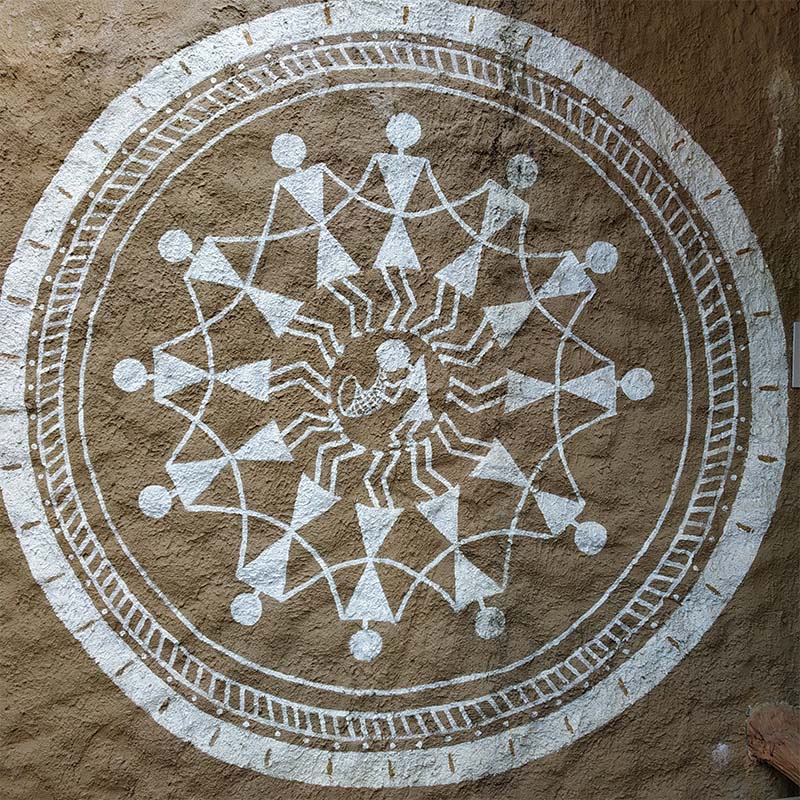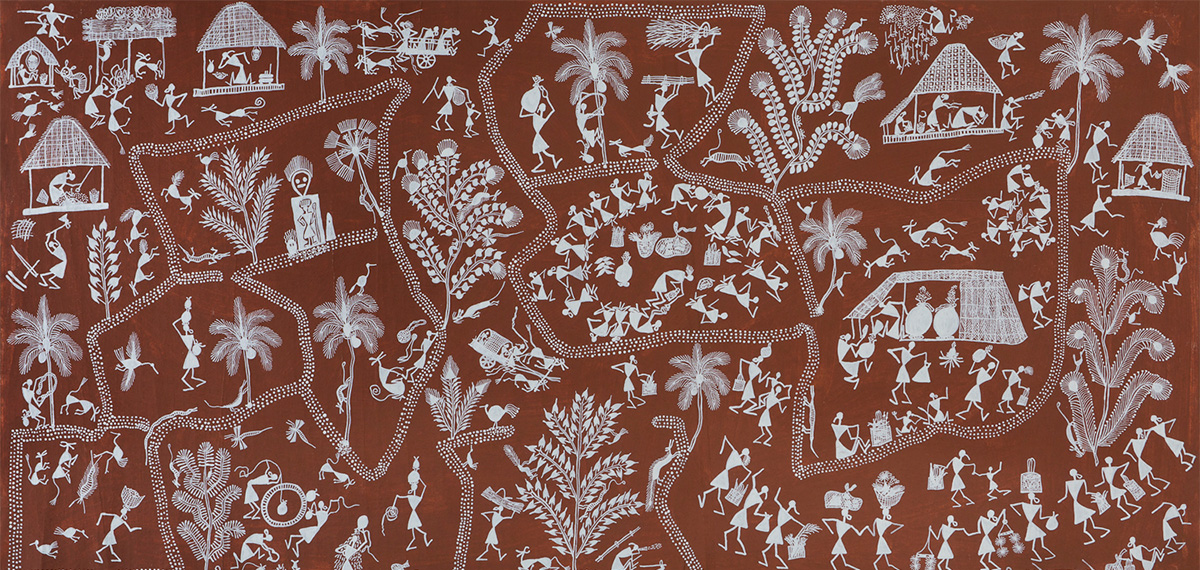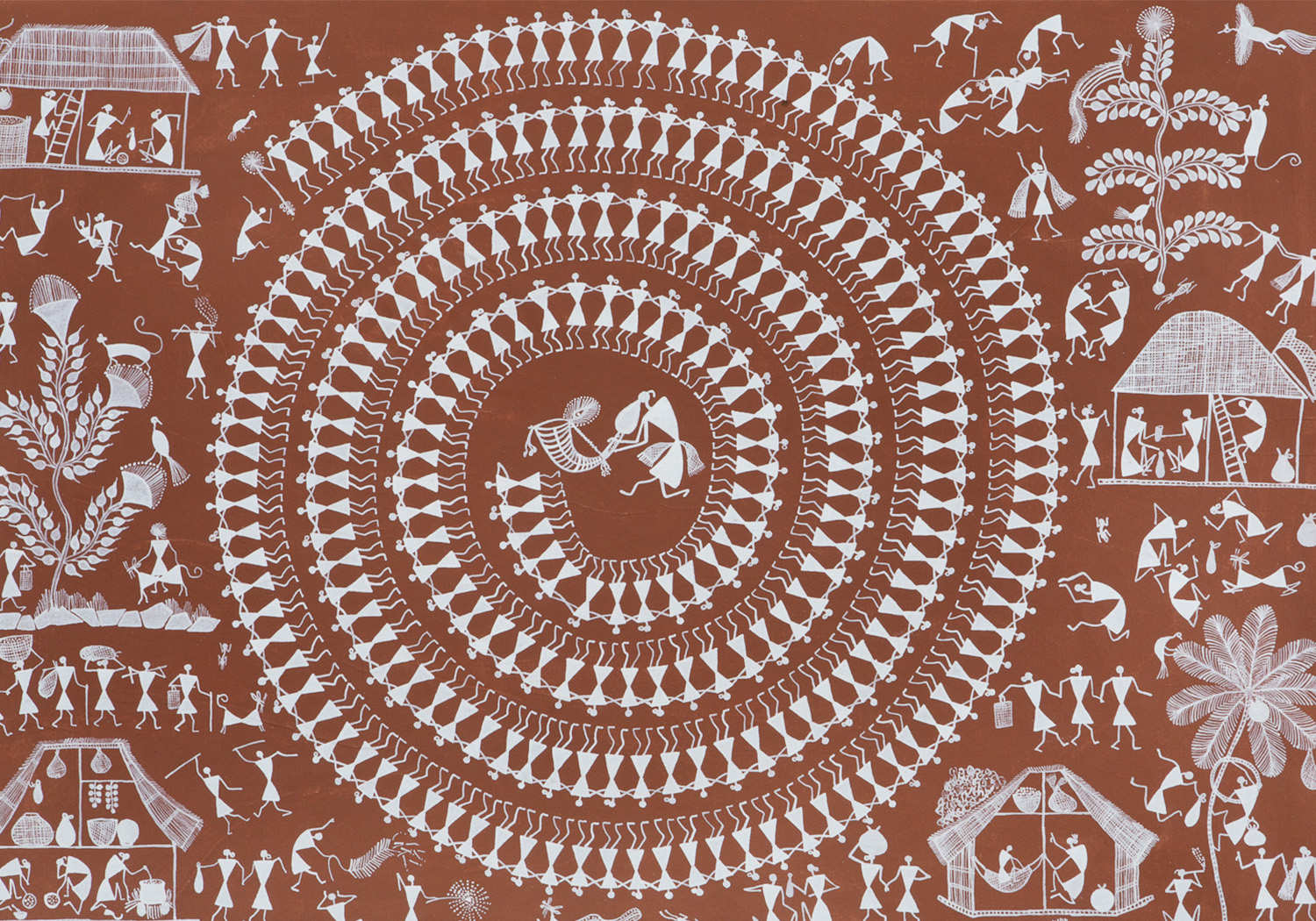ARTICLE
Warli Painting
A traditional form of mural art, Warli painting is practised by people of the Warli community in Maharashtra and parts of Gujarat. Composed of distinct motifs as well as depictions of human and animal forms, these murals were traditionally painted on the walls of mud homes during the harvest and the wedding season in these states.
While the history of the Warli community and the origins of its artistic traditions are not clearly established, some historians – noting similarities between Warli painting and the murals at the Bhimbetka rock caves – believe that Warli painting may have its roots as far back as the tenth century BCE.
Warli painting celebrates the cultural, religious and economic life of the community, depicting scenes and motifs from activities such as agriculture, fishing and hunting as well as festivals and occasions like marriages and births. Nature, which has a dominant influence on the religious beliefs of the Warli community, also features prominently in these painted murals. Lines, triangles, squares and circles are used to depict humans, animals and plants in a two-dimensional space. Landscapes including fields, rivers and the forest are clearly demarcated, and there is no overlap between the various patterns and the figures of animals or humans. Scholars speculate that the use of spiral formations and circular designs are inspired by the traditional Tarpa dance, in which members of the community gather around a musician playing the tarpa, a wind instrument made from a gourd.
Traditionally, Warli painting has been done primarily by women. Further among these women are artists called sahavasini, who specialise in painting the chawk – also known as a lagna chawk or a dev chawk – which is a ritual painting comprising a square enclosing a depiction of Palaghata Devi, the Warli goddess of fertility. It is a crucial part of Warli wedding ceremonies and members of the community sing songs before the chawk as it is painted.
The depiction of the goddess and the details of the chawk itself may vary from region to region. The square frame of the chawk is usually filled with motifs inspired by objects used during the marriage rites. In some older chawk, figures symbolising the bride and groom were depicted inside the womb of the goddess, while in other areas, the form of the goddess is composed of triangular shapes joined at the apex. Palaghata Devi is often shown with raised hands to symbolise her blessings.
During the 1970s, Warli painting caught the attention of a wider audience. This was largely due to the works of Warli artist Jivya Soma Mashe, who is credited with helping the art form gain recognition in popular and contemporary art circles. Since then, Warli painting has been adapted to different surfaces such as paper, cloth and canvas, and has incorporated the use of different materials such as acrylic colours and gum instead of the traditional rice paste. In 2014, it received a Geographical Indications (GI) tag from the Indian government.
Bibliography
Our website is currently undergoing maintenance and re-design, due to which we have had to take down some of our bibliographies. While these will be re-published shortly, you can request references for specific articles by writing to hellomapacademy@map-india.org.








![The façade of the Maneckji Seth Agiary, a Zoroastrian fire temple, is a standout example of the popularity of the Persian Revival Style in Western India in the 19th and 20th centuries. This style was often seen in the architectural patronage of the Parsis, who emerged as one of the most influential mercantile communities of British India. Popular motifs of this style, like the mythical lamasus (winged bulls with human heads) and the faravahar (a winged guardian spirit in Zoroastrianism), drew on the historical art and architecture of the Achaemenid and Sasanian empires from sites like Persepolis, Bisotun, Taq-e Bostan, Naqsh-e Rostam and Naqsh-e Rajab in Persia.
The Parsi community’s adoption of this style occurred largely due to their networks of global commerce and politics, allowing them to access and translate research of ancient Persia into visible symbols that underlined their association with antiquity, imperial power, and art.
نمای آتشکدهی زرتشتی مانِکجی سِت نمونهی بارزی از رواج سبک «احیای [معماری] ایرانی» در غرب هند طی سدههای نوزدهم و بیستم است. این سبک غالباً در بناهایی دیده میشد که پارسیان، از بانفوذترین جوامع بازرگان در هند بریتانیا، بانیشان بودند. نقشمایههای محبوب این سبک، مانند گاو بالدار اساطیری (لاماسو) و فَروَهَر (روح بالدار نگهبان در دین زرتشت)، برگرفته از هنر و معماری شاهنشاهی هخامنشی و ساسانی، در جاهایی چون تخت جمشید و بیستون و طاق بستان و نقش رستم و نقش رجب، بود.
اقتباس جامعهی پارسیان از این سبک بسیار مرهون روابط گستردهی تجاری و سیاسی آنها بود که دسترس به پژوهشها دربارهی ایران باستان و برگردانیدن آنها به نمادهای بصری را ممکن میکرد و بر پیوند پارسیان با دوران باستان و قدرت شاهنشاهی و هنر تأکید میکرد.](https://mapacademy.io/wp-content/plugins/instagram-feed/img/placeholder.png)
